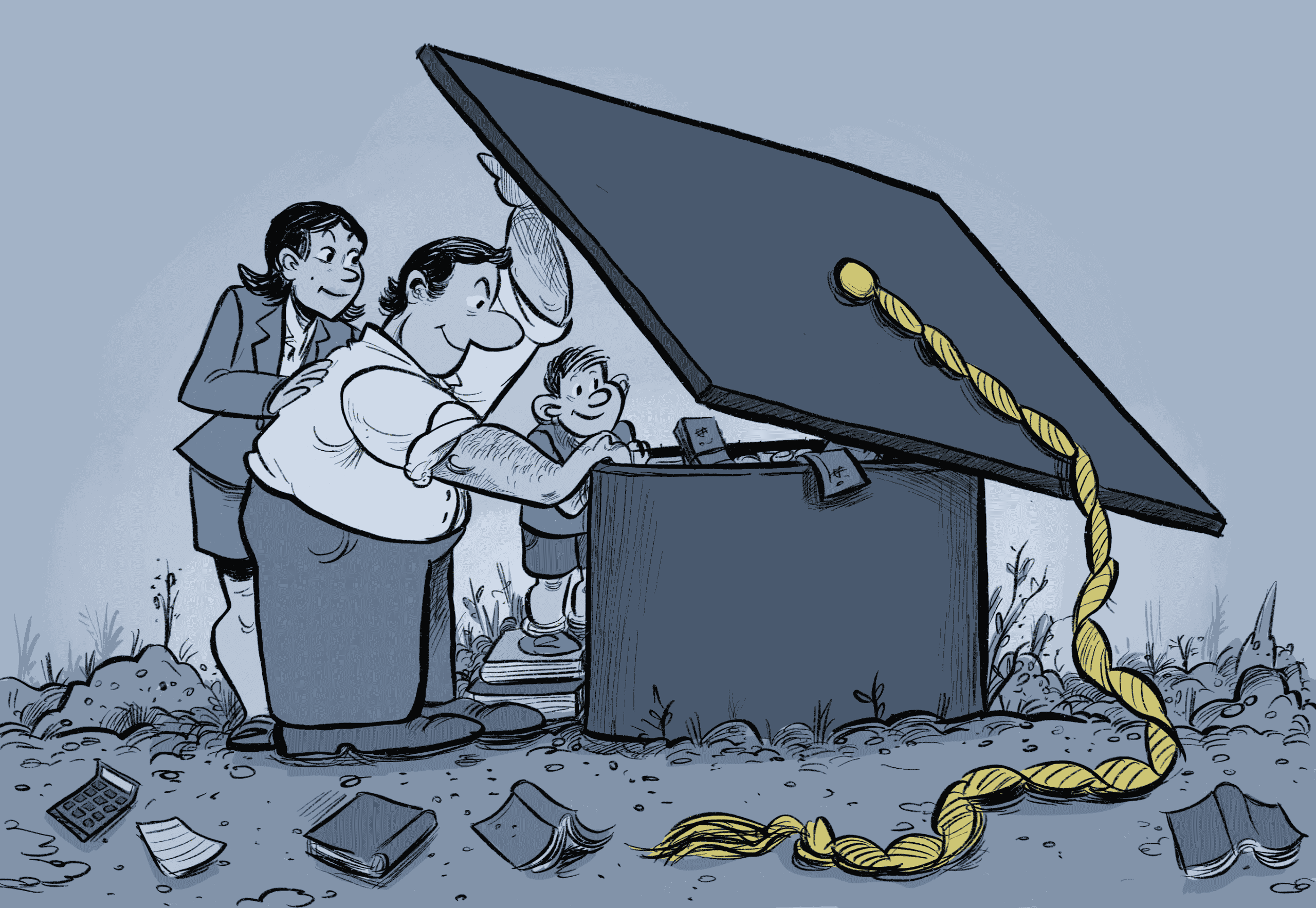
RESP Checklist: What parents need to know from birth to graduation
New babies are exciting, but so too is the day they grow up and go off to college or university. Are you ready to start saving to pay for their schooling?
When a new baby is overturning your life and household, your mind may be immediately focused on diapers and sleep schedules and washing tiny socks. But after the initial upheaval comes long-term planning. And that includes saving for their post-secondary education.
Yes, your baby may be years away from kindergarten, but there are sound reasons why parents should be saving early for college or university: For one, tuition and student housing costs are expensive and may increase further. Statistics show that by 2033, the average cost for four years of university (including residency and expenses) could reach $123,000. 1
You may need years to come up with the money.
Fortunately, a Registered Education Savings Plan (RESP) may help shoulder the financial load for parents, says Varun Bhagwat, a Financial Planner with TD Wealth. He says RESPs offer a tax-advantaged way to save for your child’s education and allows future students to receive government grants. Saving early in a registered plan also allows the funds to accumulate through compound interest over time.
“Everyone reads about rising costs, especially accommodation, in the headlines. But planning ahead can take the anxiety out of funding post-secondary education,” he says.
There are a number of intricate rules around RESPs, including who is eligible to set them up and for whom, but for the most part, we’ll be talking about what parents (or the sponsors) need to know to help finance their kids’ (or beneficiaries’) post-secondary education.
New babies are exciting, but so too is the day your child receives an acceptance letter from a university or college. Here’s what you need to know about RESPs to help you prepare for that time.
The Registered Education Savings Plan offers a structured way for parents and other benefactors to save for a child’s future education costs. The plan allows sponsors to put away money in a separate account where it can grow over time. An RESP promotes early saving and investing for post-secondary education almost as soon as the child is born, which is helpful because of the increasing costs of education.
Perhaps the most important benefit is that the federal government matches contributions to the plan up to a maximum amount. This is through the Canada Education Savings Grant (CESG). 2 Here are the numbers you should get familiar with: With every $2,500 contributed to the plans each year, the government will contribute 20% through CESG. For a contribution of $2,500, that 20% equals $500 added to the RESP and will be available to the student to help pay for their post-secondary education costs. The lifetime maximum for the CESG is $7,200.
Additional grants may also be available and certain conditions may apply. You should consider speaking with an advisor to review what options may be available.
Once funds begin to accumulate in an RESP, they are categorized into three distinct groups:
- Grant money
The portion of the plan contributed by the government in the form of the Canada Education Savings Grant, and/or other eligible grants. - Your contributions
Your principal investment, or the portion you contributed. - Your investment earnings or income
The portion accrued from the growth of the investments in the plan and any interest earned. When withdrawal time arrives, the grants and investment earnings are referred to as the Educational Assistance Payment (EAP), while your contributions are referred to as the Post-Secondary Education (PSE) withdrawals.
There are also tax benefits. The earnings are tax deferred and, when the time comes to withdraw funds in order to pay for your child’s post-secondary education, the earnings are taxed to the student. Students may pay little to no taxes as they typically fall into the lowest tax bracket. 3
Within an RESP you can hold a variety of investing options such as Guaranteed Investment Certificates and mutual fund investments. RESPs can also simply hold cash in the plan; however, this may not optimize the earning potential of the savings. There are two common types of RESP to consider: Family RESPs which allow you to name more than one beneficiary, subject to certain criteria, or an individual RESP which can be dedicated to a specific child.
When the time comes to use the funds, the student will typically withdraw funds saved through the RESP to pay for their education costs until the funds are depleted. If a child does not pursue a post-secondary education, it’s best to consult with your advisor on the options available, including possibly closing the plan.
It’s often beneficial to open an account as soon as a child is born in order to contribute for as many years as possible. When a child is born, the parents must register their bundle of joy at the appropriate “Live Birth Registry” in their province. This allows the parents to receive a birth certificate but also a social insurance number which is needed for the registration of an RESP. Once you have a social insurance number in hand, you can contact your bank to set up an RESP. In Ontario, parents can access an education savings referral from the birth registry which will put them in touch with a financial advisor.
You can begin to save for a child’s education whenever you’re able and you can continue to add to a child’s RESP until it either hits the maximum lifetime contribution limit ($50,000), or the student reaches the age of 31: The maximum time an RESP can remain open is 35 years. 4 Even if you get a late start, contributions can continue to grow after a child is enrolled in a post-secondary school but, to get the full benefit of the RESP, it’s recommended to contribute as early as possible. Note, the latest a student can receive a CESG grant is the last day of the year they turn 17, but you must start to save for your child before the end of the calendar year in which they turn 15 in order to be eligible for the CESG. 5
To maximize funds for future education, the best way to manage an RESP is through consistent contributions, both to allow interest to compound over time and to ensure you qualify for the full allowance of grant money. While there is a maximum $50,000 contribution limit, there are no rules on the minimum amount you must save through an RESP — the government will match 20% of your contribution up to a maximum of $500 annually (and to a total maximum of $7,200 over the life of the RESP). 6 That “free” grant money can be a valuable boost to your savings if you start contributing early.
With the goal of accumulating as much money as possible — and with a wide variety of investment options available — parents should consider speaking with a advisor about which investments may be appropriate for their child’s RESP. Solid investment strategies will take into consideration the number of years left before the money is needed, as well as the parent’s overall investment profile. It may also be valuable to speak with a financial advisor when the time nears for the child to go off to college or university, as funds may need to be prepared for withdrawal.
You can use an RESP calculator to see how much you may need to save and invest to pay for a child’s education. The calculator can estimate the costs of tuition and other related expenses, the returns on your investments over time, plus how much grant money your student may receive.
To estimate how much money you can save through an RESP, check out the TD RESP calculator.
One option for saving regularly in an RESP is automatic deposits. You can set up automated deposits from your bank account as a convenient way to contribute to the RESPs. In this way, your savings may begin accumulating more rapidly than making a lump sum deposit once a year. Learn more about setting up automatic deposits.
When you open an RESP, you can choose to open an account for an individual plan which is specific to one child, or a family plan, for more than one child.
The individual plan is straightforward: The funds can only be used by the individual beneficiary named in the plan and the beneficiary does not have to be related to you. For the family plan, the beneficiaries must be related to you either by blood or adoption, either children, stepchildren, grandchildren (including adopted grandchildren), brothers or sisters — nieces, nephews, aunts, uncles and cousins are not considered blood relatives — and all beneficiaries must be under the age of 21 when they are designated for a family RESP.
Some parents may find a family RESP offers needed flexibility as the contributions and grants (to a maximum $7,200 per beneficiary) can be shared amongst the beneficiaries in the plan. Not every beneficiary may decide to follow the same path to study at a university or college. And not every course or academic discipline will run up the same education costs.
Picture a family with twins: Their parents may not anticipate that, if one travels out of province for medical school, and the other lives at home to complete a trade apprenticeship, their financial needs may be different. If the parents had individual plans for each twin and the maximum contributions were made, the parents could find one RESP suffering a shortfall because of high tuition costs while they may have over-contributed to the other. A family RESP may be a solution in this case because the siblings can essentially share the contributions. In fact, if one child doesn’t go to a post-secondary institution, their sibling can enjoy all the contributions made in a family plan up to the maximum limits. Check out, Individual or Family RESP: Which is right for you?
With individual RESPs, you don’t need to be related to the beneficiary to open the plan. The circumstances are rare, but even adults can enroll themselves in an RESP. While the vast majority of RESPs are opened by parents, that does not mean grandparents, godparents and family friends can’t also enroll children in an RESP. However, there are some considerations to be aware of and it may be simpler for a relative to give money to a parent so that it can be directed to one RESP.
One consideration to be aware of: RESPs have maximum contribution and grant limits which apply to each beneficiary regardless of how many RESPs are opened for them. For example, a beneficiary may be enrolled in multiple RESPs but the total maximum contribution limit for that beneficiary remains $50,000. That means a well-meaning grandparent who opens a second RESP for a child could find themselves overcontributing to the plan if they are not aware of the amounts contributed to the other RESPs.
There are other considerations to think about, including: a benefactors’ ability to maintain their own cashflow while contributing and how the RESP would be treated in event of the death of a subscriber. Check out, Grandparents and RESPs: Hope (and Help) for the Future.
When your child is accepted to a university or college, it is a proud day for everyone. If you are a parent who has been saving throughout your child’s lifetime, you can congratulate yourself for being so forward thinking.
But the job is not over. Withdrawing funds from an RESP can take a bit of organization, both to get the maximum financial benefit and to ensure school expenses are paid.
The first task is to get organized and know ahead of time what you need to do and when. If you invest in GICs or mutual funds within your RESP, you may even start planning a year out to turn some of your investments into cash for withdrawal. Remember that the funds in an RESP are comprised of three “buckets” or portions:
- Grant money
The portion of the plan contributed by the government in the form of the Canada Education Savings Grant, and/or other eligible grants. - Your contributions
Your principal investment, or the portion you contributed. - Your investment earnings or income
The portion accrued from the growth of the investments in the plan and any interest earned.
When withdrawal time arrives, the grants and investment earnings are referred to as the Educational Assistance Payment (EAP), while your contributions are referred to as the Post-Secondary Education (PSE) withdrawals.
It may be wise to acquaint yourself with the RESP withdrawal form at your financial institution early on and ask for some help from your financial advisor. For the withdrawal, you must decide which “bucket” you wish to draw from: 1) the grant money, 2) your contributions, or 3) any income earned on those contributions and grants. It’s usually best to withdraw from the grant portion of the RESP first. It is the only portion you would otherwise be ineligible to withdraw if the beneficiary decides not to pursue post-secondary schooling. You should also keep in mind that in the first 13 weeks of school, there are withdrawal limits of $5,000 (or $2,500 if the student is enrolled part time) from the grant and income-earned portions (EAP) of the RESP. For school expenses that may exceed that figure, you can still withdraw from your contribution portion (PSE) of your RESP.
You’ll also want to find out what kind of documentation is needed to prove the beneficiary has been enrolled in a post-secondary institution, such as a “Letter of Enrollment” from the school’s registrar, as well as what is involved to request (and pay) for any documentation. You can learn more about RESP withdrawal rules here.
Typically, a student will be faced with tuition and housing costs, plus miscellaneous costs for books, meals and transportation. The funds from RESPs can be used for anything related to school — to buy a computer, pay for the cost of travelling to a new city for school or even to buy a new desk lamp. For the most part, you do not need to save receipts for purchases made from the funds withdrawn from the RESP. In a rare instance when you may be withdrawing a substantial amount from the grant portion of the RESP, the Educational Assistance Payment (EAP), you may be required to provide receipts if the amount is more than the indexed limit. In 2022, that limit is $25,268.
Naturally, as a subscriber to an RESP, you may want to know what happens if a beneficiary chooses a career path that doesn’t include post-secondary education. It’s important to understand that RESPs can remain in place for 35 years: If a beneficiary changes their mind about school in their 20s, the RESP can still be there for them. If the student does not pursue post-secondary education, it’s best the parent speaks with a financial advisor on what options are available for closing the RESP.
DON SUTTON
MONEYTALK LIFE
ILLUSTRATION
DANESH MOHIUDDIN
- Actuarial report on the Canada Student Loans Program, Office of the Superintendent of Financial Institutions Canada, July, 2016, p. 18, accessed June 30, 2022, https://www.osfi-bsif.gc.ca/Eng/Docs/CSLP_2016.pdf ↩
- Educational Savings Grant, Government of Canada, Jan. 18, 2022, accessed Aug. 09, 2022, www.canada.ca/en/revenue-agency/services/tax/individuals/topics/registered-education-savings-plans-resps/canada-education-savings-programs-cesp/canada-education-savings-grant-cesg.html ↩
- Educational Assistance Payments (EAPs), Government of Canada, April 7, 2022, accessed Aug. 09, 2022, www.canada.ca/en/revenue-agency/services/tax/individuals/topics/registered-education-savings-plans-resps/payments-resp/educational-assistance-payments-eaps.html ↩
- Educational Assistance Payments (EAPs), Government of Canada, April 7, 2022, accessed Aug. 09, 2022, www.canada.ca/en/revenue-agency/services/tax/individuals/topics/registered-education-savings-plans-resps/payments-resp/educational-assistance-payments-eaps.html ↩
- Canada Education Savings Grant (CESG), Government of Canada, Jan. 18, 2021, accessed Sept. 23, 2022. www.canada.ca/en/revenue-agency/services/tax/individuals/topics/registered-education-savings-plans-resps/canada-education-savings-programs-cesp/canada-education-savings-grant-cesg.html ↩
- RESP Rules and Contribution Limits, TD Bank, accessed Aug. 09, 2022, www.td.com/ca/en/personal-banking/personal-investing/learn/resp-contribution-limit-rules-canada/ ↩












